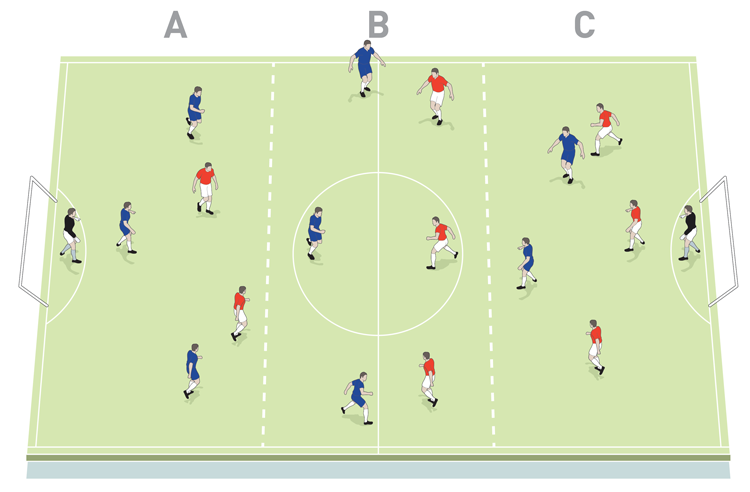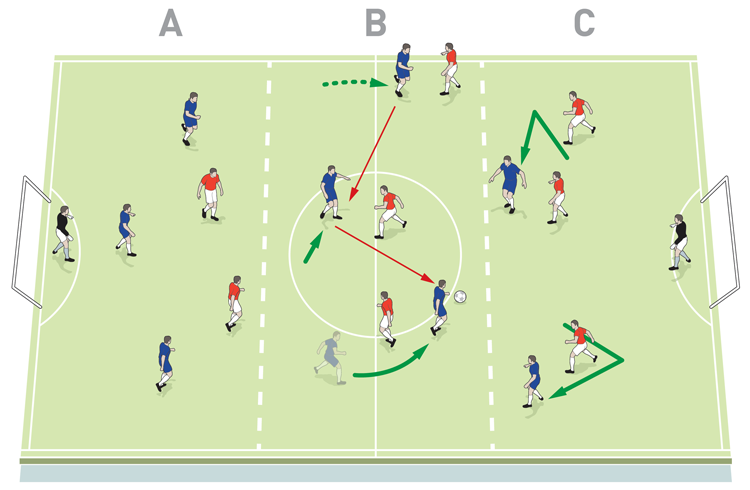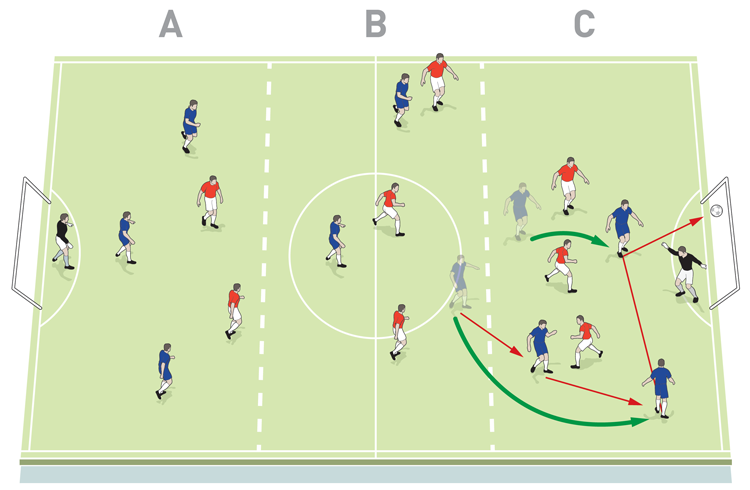You are viewing 1 of your 1 free articles
Possession: tactical play
Use this session to play an open, expansive, forward-thinking passing game, with an emphasis on quick play and forward running. It involves how players should react when the team is in possession and moving upfield.
| Area | Use of a full pitch |
| Equipment | Balls, cones, goals |
| No. of Players | Up to 11v11 |
| Session Time | Main practice 12mins, Progression 12mins, 11v11 12mins |
Our objective at Peterborough United is to play an open, expansive, forward-thinking passing game, with an emphasis on quick play and forward running. As a result, this is a session we have devised which looks at how players should react when the team is in possession and moving upfield.
What makes this practice unique and engaging is the way it incorporates the core elements of our possession game, but also creates defensive problems that reflect the typical game situation.
We will run this session at least once a week, sometimes twice. It reminds the players of so many of the ‘in-game’ habits we want to see that it forms a core part of the training framework, so is very important to us.
What do I get the players to do?
Main practice
The main practice involves teams of nine, split into three zones. As an area, we are using the space in between the penalty boxes, restricted to the 44-yard width, as shown (1). Ultimately, we are looking for two teams to attack with the simple aim of scoring goals, but at each intersection there is a defined key aspect that we’re looking to extract from the play, as follows, and using the A, B and C thirds as a guide:
1

Key aspect 1: Encouraging quick play in moving the ball forward (2)
The attacking team has two touches in its defensive third, three touches in the middle third and is ‘all in’ in the attacking third. Setting up with these conditions means quick and positive offensive play in getting the ball to attackers.
2

Key aspect 2: Encouraging movement (3)
Once the ball has been passed forward into a new third it cannot be passed back out. As a result, forward players will need to spread out and find space in which to move as the passage of play comes towards and moves around them, because it cannot go backwards.
3

Key aspect 3: Encouraging forward running and overload awareness (4)
A ball cannot be carried over a line, but once it is played over the line, the player who made the pass may follow it; however, no defender may follow. This moves players in the mindset of following play and being responsible for the next phase of play once a pass has been made.
4

Key aspect 4: Encouraging progressive passing (not shown)
The ball must be played through all thirds and a goal can only be scored in the attacking third. This method ensures players understand the value of passing and linking up, since it is the only method by which they can score - other types of goals (for instance, long shots) aren’t allowed to count.
How do I progress the session?
The logical progression of the first part of the session is to allow free movement of players into any zone, but the same touch and ball-carrying restrictions apply. Essentially, we want to see all of the same principles, yet with a freer flow of players into all areas to see the challenges and opportunities those situations will provide.
What are the key things to look out for?
The key aspects outlined create the bedrock for what we want players to get out of the session, though we also need to protect against mistakes happening. Mainly these will show themselves as too many touches in restricted zones because of poor initial positioning, a failure to run forward (which puts more pressure on players in possession), and ‘low speed’ movements (which limits space).
How do I put this into a match situation?
The game can be expanded into an 11v11 on a full-sized pitch without any markings or restrictions, but with an emphasis on sustaining the technical and tactical themes from the smaller session.
Related Files
Editor's Picks
Deep runs in the final third
Using the goalkeeper in build-up play
Pressing principles
Intensive boxes drill with goals
Penetrating the final third
Creating and finishing
My philosophy
Pressing initiation
Compact team movement
Coaches' Testimonials

Alan Pardew

Arsène Wenger

Brendan Rodgers

Carlos Carvalhal

José Mourinho

Jürgen Klopp

Pep Guardiola

Roy Hodgson

Sir Alex Ferguson

Steven Gerrard
Coaches' Testimonials

Gerald Kearney, Downtown Las Vegas Soccer Club

Paul Butler, Florida, USA

Rick Shields, Springboro, USA

Tony Green, Pierrefonds Titans, Quebec, Canada
Join the world's leading coaches and managers and discover for yourself one of the best kept secrets in coaching. No other training tool on the planet is written or read by the calibre of names you’ll find in Elite Soccer.
In a recent survey 92% of subscribers said Elite Soccer makes them more confident, 89% said it makes them a more effective coach and 91% said it makes them more inspired.
Get Monthly Inspiration
All the latest techniques and approaches
Since 2010 Elite Soccer has given subscribers exclusive insight into the training ground practices of the world’s best coaches. Published in partnership with the League Managers Association we have unparalleled access to the leading lights in the English leagues, as well as a host of international managers.
Elite Soccer exclusively features sessions written by the coaches themselves. There are no observed sessions and no sessions “in the style of”, just first-hand advice delivered direct to you from the coach.









